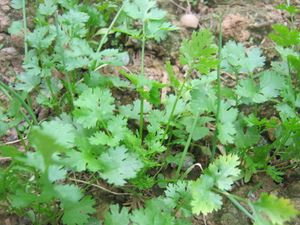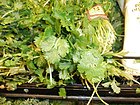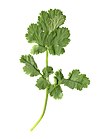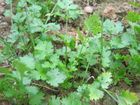Note: This is a project under development. The articles on this wiki are just being initiated and broadly incomplete. You can Help creating new pages.
Difference between revisions of "Coriandrum sativum - Dhanyaka"
(→References) |
(→Chemical Composition) |
||
| Line 10: | Line 10: | ||
==Chemical Composition== | ==Chemical Composition== | ||
| − | + | Coriander contains 0.5–1% volatile oil, consisting mainly of delta-linalool (55–74%), alpha-pinene and terpinine. It also contains flavonoids, coumarins, phthalides and phenolic acids (including caffeic and chlorogenic). Aqueous extract of the roasted seeds contains large amounts of acetylcholine and its precursor choline. <ref name="chemical composition"/> | |
==Common names== | ==Common names== | ||
Revision as of 12:27, 25 June 2019
Coriandrum sativum is aromatic annual plant of the parsley family Apiaceae. It has slender stems with two types of lobed leaves and can grow up 90 cm or 3 feet tall.
Contents
- 1 Uses
- 2 Parts Used
- 3 Chemical Composition
- 4 Common names
- 5 Properties
- 6 Habit
- 7 Identification
- 8 List of Ayurvedic medicine in which the herb is used
- 9 Where to get the saplings
- 10 Mode of Propagation
- 11 How to plant/cultivate
- 12 Commonly seen growing in areas
- 13 Photo Gallery
- 14 References
- 15 External Links
Uses
Skin disorders, Eczema, Dryness, Fungal infections, Heart attacks, Artherosclerosis, Strokes, Diarrhea, Blood pressure.
Parts Used
Chemical Composition
Coriander contains 0.5–1% volatile oil, consisting mainly of delta-linalool (55–74%), alpha-pinene and terpinine. It also contains flavonoids, coumarins, phthalides and phenolic acids (including caffeic and chlorogenic). Aqueous extract of the roasted seeds contains large amounts of acetylcholine and its precursor choline. [1]
Common names
| Language | Common name |
|---|---|
| Kannada | Havija, Kotambari |
| Hindi | Dhaniya |
| Malayalam | Kotta-malli, Kottam-palari |
| Tamil | Kotthu malli, Arainili, Aritaravanci, Avarika, Cottamillie |
| Telugu | Danyalu, Dhaniyaalu, Dhanyalu |
| Marathi | NA |
| Gujarathi | NA |
| Punjabi | NA |
| Kashmiri | NA |
| Sanskrit | Vedhaka, Veshana, Vitunnaka, Dhanyaka |
| English | Coriander |
Properties
Reference: Dravya - Substance, Rasa - Taste, Guna - Qualities, Veerya - Potency, Vipaka - Post-digesion effect, Karma - Pharmacological activity, Prabhava - Therepeutics.
Dravya
Rasa
Madhura (Sweet)
Guna
Laghu (Light), Snigda(unctuous)
Veerya
Ushna (Hot), Sheet (Cold)
Vipaka
Madhura (Sweet)
Karma
Kapha, Vata
Prabhava
Habit
Identification
Leaf
| Kind | Shape | Feature |
|---|---|---|
| Simple | compound | Leaf arrangement is alternate and there is one leaf per node along the stem |
Flower
| Type | Size | Color and composition | Stamen | More information |
|---|---|---|---|---|
| Unisexual | 2-4cm long | pink to red | 5-20 | there are two or more ways to evenly divide the flower and there is only one way to evenly divide the flower |
Fruit
| Type | Size | Mass | Appearance | Seeds | More information |
|---|---|---|---|---|---|
| general | length is 2–6 mm | Fruit type is the fruit is dry but does not split open when ripe | With hooked hairs | {{{6}}} |
Other features
List of Ayurvedic medicine in which the herb is used
Where to get the saplings
Mode of Propagation
How to plant/cultivate
Grow in fertile, well drained soil in full sun where seeds are to be gathered. For leaf production partial shade is more productive[4]
Commonly seen growing in areas
Mediterranian region, meadows.
Photo Gallery
References
External Links
- Ayurvedic Herbs known to be helpful to treat Skin disorders
- Ayurvedic Herbs known to be helpful to treat Eczema
- Ayurvedic Herbs known to be helpful to treat Dryness
- Ayurvedic Herbs known to be helpful to treat Fungal infections
- Ayurvedic Herbs known to be helpful to treat Heart attacks
- Ayurvedic Herbs known to be helpful to treat Artherosclerosis
- Ayurvedic Herbs known to be helpful to treat Strokes
- Ayurvedic Herbs known to be helpful to treat Diarrhea
- Ayurvedic Herbs known to be helpful to treat Blood pressure
- Herbs with Seeds used in medicine
- Herbs with Leaves used in medicine
- Herbs with common name in Kannada
- Herbs with common name in Hindi
- Herbs with common name in Malayalam
- Herbs with common name in Tamil
- Herbs with common name in Telugu
- Herbs with common name in Sanskrit
- Herbs with common name in English
- Habit - Herb
- Index of Plants which can be propagated by Seeds
- Herbs that are commonly seen in the region of Mediterranian region
- Herbs that are commonly seen in the region of meadows
- Herbs
- Apiaceae







